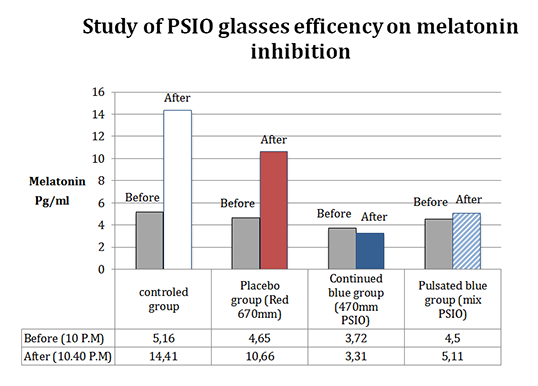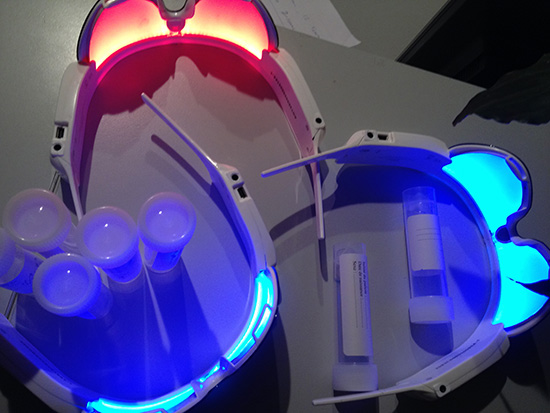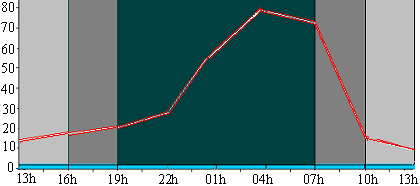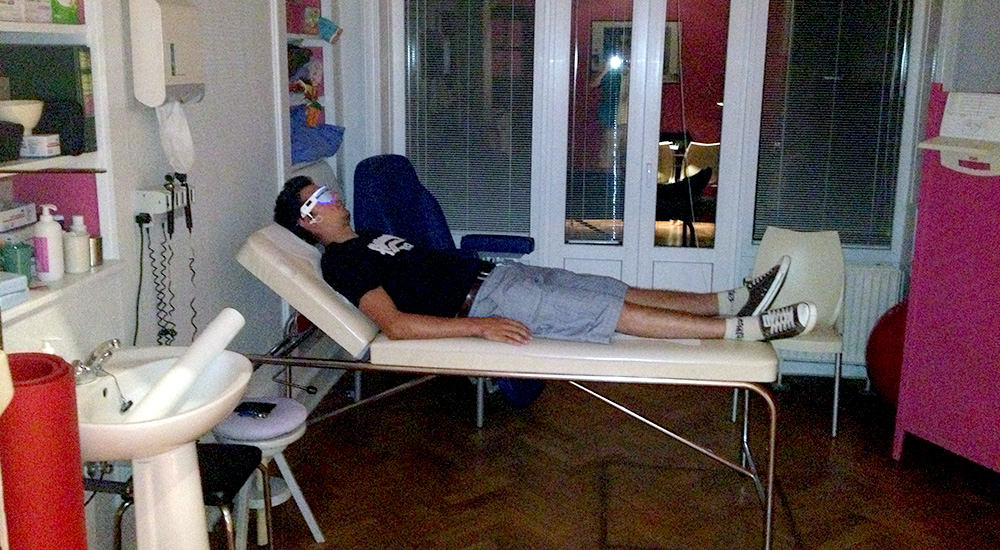Study of the PSiO glasses efficiency as for the inhibition of melatonin
Comparative analysis of the inhibition of melatonin: between blue light (470 nm) continuous stimulation and blue flickering light (470 nm) combined with a variable frequency audio-visual stimulation program.
- Stéphane Krsmanovic-Dumonceau, scientific collaborator at the University of Brussels - ISEPK- Belgium (e-mail : stephane@psio.com)
- Nicolas d'Offay (e-mail : nicolas@psio.com)
Lindenhof clinic - 1, square Marie José, 1200 Brussels - Belgium - August 2013

Abstract: Several studies have shown the influence of the inhibition of melatonin by blue light (470 nm) (1) In the following report we have tested the effect of continuous blue light - emitted by the PSiO device without sound stimulations (the PSiO is a pair of glasses equipped with a MP3 player and eye-glasses emitting colored lights) - on the production of melatonin at 10 PM and the difference with an audio-visual stimulation with variable frequency and intensity (also with the PSiO glasses) using same range of wave length (470 nm). The study has considered four groups of students aged between 18 to 26 y.o. and the experiment was conducted at 10 PM when the curve of melatonin production has already begun to increase since one hour approximately. The four groups were proposed to do a rest on a comfortable clinic table with or without PSiO glasses, rest time being for all groups of 30 min. Group 1 was a control group doing just a rest without the PSiO in a room with controlled light of 75 watts; Group 2 was designed as a placebo group with a pair of PSiO glasses but emitting only a continuous (670 nm) red light (without any sound stimulations). Group 2 was considered as a “placebo” group, as red light being know by several studies having no effect on the inhibition of melatonin; Group 3 was the group practicing a similar session with same PSiO glasses but emitting only blue light (470 nm) on the continuous mode (without any sound stimulations) and Group 4 was a group practicing a normal session of audio-visual stimulation with a range of colored blue light frequencies (470 nm).
Dominant wave length of 3 RGB LEDs used in PSiO
| Values |
Unit |
| Red |
Green |
Blue |
Nanometers (nm) |
| 625 |
528 |
470 |

Lindenhof clinic, Brussels
Results : have already showed that the control group (1) had a normal increase of melatonin production; the Placebo group (2) had a similar increase of melatonin production and was responding exactly like the control group proving that the PSiO has no placebo effect concerning the inhibition of melatonin. Group (3), The PSiO continuous blue light (470 nm) stimulation group, was responding with a strong inhibition of melatonin, and a small decrease in melatonin level was recorded compared with the base measurement. Group (4), the PSiO audio-visual stimulation group obtained also a strong similar inhibition of melatonin. Preliminary conclusions are that PSiO glasses, using a continuous blue light stimulation (470 nm) or a range of pulsated emitting blue light stimulations combined with audio stimulations have both a strong inhibition effect on the melatonin production at 10 PM.
It should be noted that Group 4 obtained a similar inhibition as Group 3 while the time of exposure to blue light was reduced by half at the minimum (light pulsation implies that diodes are ‘on' 50% of the time and ‘off' 50% of the time). Furthermore, part of the session (probably 50 %) took place with eyes closed due to a major ‘letting go' that appears automatically with light pulsation. Therefore, inhibition of the melatonin level with pulsed blue light could be similar to that of blue continuous light, taking into account that exposure time to blue light could be of only 25% compared with blue continuous light. A new study comparing a group receiving the stimulation session with eyes closed during the time of the test should be the next experiment.
Melatonin production
Linked to the daylight, the melatonin production curve begins around 9 - 10 PM, has its maximum around 3 AM and decreases radically its production from 7 AM to 10 AM. The study has thus tested the inhibition of the melatonin production just when the production curve is growing radically.

Daily curve of melatonin secretion
Melanopsin Discovery
In 2002, David Berson at Brown University in the USA, discovered the missing link in the regulatory mechanisms of the biological clock: The ganglion cells in the inner retina (in front of the rods and cones) contained a photopigment called melanopsin. This newly discovered receptor matched perfectly with the ‘action spectrum' of blue light. Now that scientists identified melanopsin, they were able to trace its projections via the retinohypothalamic tract to the SCN in the hypothalamus and other areas in the brain. (1)
This discovery meant that the eyes also transmit light through a non-visual system, and studies comparing the visual against the non visual system show that the blue-light melanopsin pathway was not only responsible for regulating our circadian system, but the alerting system as well.

Lindenhof clinic, Brussels
How to consider the use of a PSiO glasses :
A. Via blue light : regulation of jet lag and improvement of intellectual work
The PSiO glasses can also, using specific programs complemented with blue light at a specific wavelength, regulate jet lag by inhibiting the secretion of melatonin (as clearly shown in this study) and also improve the intellectual work. Memory, attention and reaction time, alertness, learning ability and cognitive processes can all be improved by exposure to blue light. Indeed, a study by Dr. Lehrl and colleagues in Germany showed an immediate improvement in the learning process equivalent to an increase of 5 IQ points (2).
B. Audio Visual Stimulation : putting attention at rest and restore the cortex
Regardless of the effect of light, the pulsations emitted by the PSiO create a strong distraction of attention. After a few minutes the attention begins to float and is progressively put at rest throughout the session. This specific effect, that of restoration of cortical cells, also improves the ability of the mind to increase alertness and to promote all the neural processes involved in an intellectual effort. A study at an American university showed an improvement in cognitive function after audio-visual stimulation (3).
C. Stimulation by voice
The PSiO is a device that proposes audio programs designed for stress management, anti-depressants or programs for deep rest guided by voices.
Conclusion
For these three reasons, the PSiO is efficient and has quick results. With specific programs (such as the effect of positive suggestions, the effect of blue light or that of the attention put at rest by audio-visual stimulations), the PSiO allows a consequent restoration of cortical neurons and plays a synergistic role to improve cognitive function, but also improves daily mood and also induces a state of general well-being.
The Full Study
The links
(1) Phototransduction in ganglion-cell photoreceptors - Dr. David Berson at Brown University - European Journal of Physiology© Springer-Verlag 200710.1007/s00424-007-0242-2
(2) Blue Light improve cognitive performance - Dr. Lehrl & collegues - Journal of neural transmission.
Department of Psychiatry and Psychotherapy, University of Erlangen-Nuremberg, Erlangen, Germany.
Published online: January 25, 2007
(3) Study of efficacy of the MC2 AVS device - Dr. Joseph Tracy - Int.J.Learning Technology, Vol.3, N°2, 2007
|